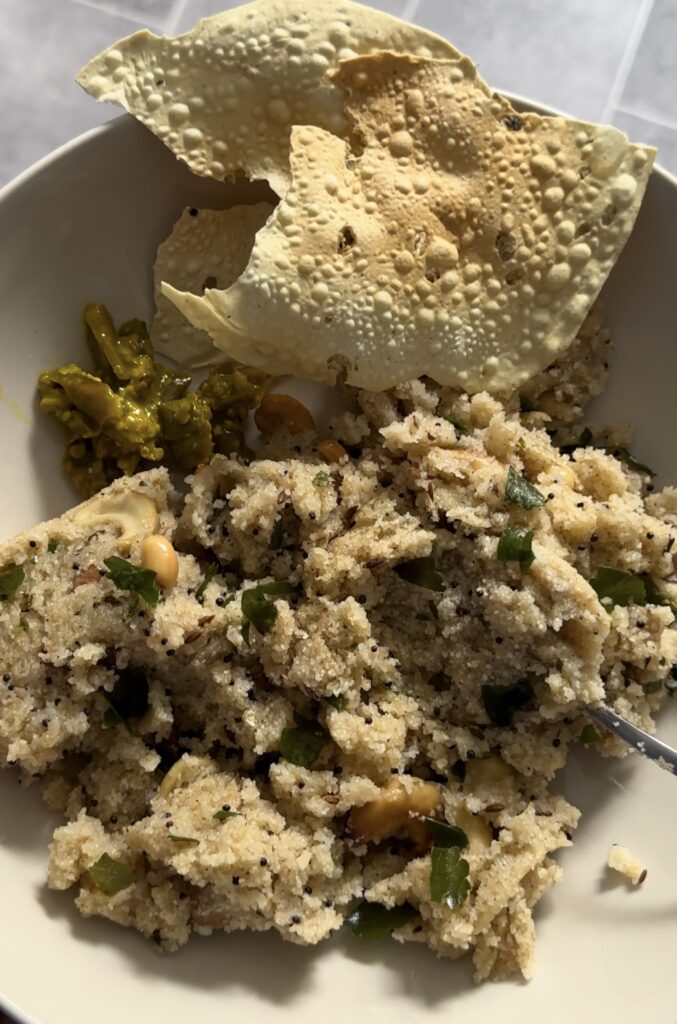A Nutritious and Flavorful South Indian Delight!
Upma is a quintessential South Indian breakfast dish that has gained popularity across India and beyond. Made from semolina (sooji/rava), this savory dish is flavored with a variety of spices and often enhanced with nuts, curry leaves, and vegetables. In this article, we will explore the origins of upma, its health benefits, and its cultural significance.
Origins of Upma
Upma, also known as uppumavu or uppittu, traces its roots to South India. It is a staple breakfast item in the states of Tamil Nadu, Kerala, Karnataka, Andhra Pradesh, and Telangana. The name "upma" is derived from the Tamil words "uppu" (salt) and "mavu" (flour), reflecting its basic ingredients. Over time, upma has evolved to include a variety of flavors and ingredients, making it a versatile and beloved dish.
Historically, upma was a simple preparation, often made with minimal ingredients like semolina, water, and salt. However, as culinary techniques evolved, so did the dish. Today, upma can be found in many forms, with variations that include vegetables, nuts, and spices, each adding a unique twist to the traditional recipe.
Cultural Significance of Upma
Upma holds a special place in South Indian cuisine, often served as a breakfast dish but also enjoyed as a light meal or snack throughout the day. Its ease of preparation and adaptability make it a popular choice for busy households. In many South Indian homes, upma is considered a comfort food, offering a warm, savory start to the day.
The dish is also significant in festive and religious contexts. During festivals and special occasions, upma is often prepared as part of a larger meal, showcasing the rich culinary heritage of South India. Its simple ingredients and quick preparation time make it an ideal dish for feeding large gatherings.
Health Benefits of Upma
Upma is not only delicious but also packed with numerous health benefits. Here are some of the key health advantages of incorporating upma into your diet:
- Rich in Nutrients: Semolina, the main ingredient in upma, is a good source of essential nutrients like protein, fiber, and B vitamins. These nutrients play a crucial role in maintaining overall health and well-being.
- Low in Calories: Upma is relatively low in calories, making it an excellent choice for those looking to maintain or lose weight. The dish is filling and satisfying, helping to curb hunger and prevent overeating.
- Promotes Digestive Health: The fiber content in semolina aids in digestion and helps prevent constipation. Additionally, the inclusion of curry leaves and ginger in the recipe provides further digestive benefits.
- Supports Heart Health: The use of healthy fats like ghee or oil in moderation, along with the inclusion of nuts like peanuts and cashews, provides heart-healthy monounsaturated fats. These fats help reduce bad cholesterol levels and promote cardiovascular health.
- Boosts Immunity: The spices and herbs used in upma, such as curry leaves, green chilies, and ginger, have immune-boosting properties. These ingredients contain antioxidants and anti-inflammatory compounds that help strengthen the immune system.
- Provides Sustained Energy: The complex carbohydrates in semolina provide a steady release of energy, making upma an ideal breakfast option. It helps keep you energized and focused throughout the morning.
Variations of Upma
Upma's versatility allows for numerous variations, each with its unique flavor profile and ingredients. Some popular variations include:
- Vegetable Upma: This version includes a mix of vegetables such as carrots, peas, beans, and bell peppers. The vegetables add color, texture, and additional nutrients to the dish.
- Tomato Upma: Tomato upma is made by adding ripe tomatoes to the basic upma recipe. The tomatoes add a tangy flavor and a vibrant color to the dish.
- Lemon Upma: Lemon juice is added to the upma just before serving, giving it a refreshing and tangy twist. This variation is particularly popular in the summer months.
- Bread Upma: Instead of semolina, bread pieces are used to make this version of upma. It is a great way to use up leftover bread and is quick to prepare.
- Broken Wheat (Dalia) Upma: For a healthier option, broken wheat or dalia is used instead of semolina. This version is higher in fiber and has a lower glycemic index, making it suitable for diabetics.
Upma as a Versatile Meal
One of the reasons upma is so beloved is its versatility. It can be enjoyed at any time of the day and is suitable for various dietary preferences. Here are some ways to enjoy upma:
- Breakfast: Upma is a popular breakfast choice because it is quick to prepare and provides sustained energy. Pair it with a cup of hot tea or coffee for a complete meal.
- Light Lunch or Dinner: Upma can be enjoyed as a light lunch or dinner, especially when you're short on time. Add a side of yogurt or a simple salad to make it more filling.
- Snack: Upma makes for a great snack option. You can prepare a small batch and enjoy it as a mid-morning or evening snack.
- Travel Food: Upma is also a convenient travel food. It can be packed easily and consumed cold or at room temperature, making it ideal for road trips or picnics.
Upma is a classic South Indian dish that has stood the test of time. Its simplicity, versatility, and health benefits make it a beloved choice for breakfast, lunch, dinner, or a snack. Whether you prefer the traditional version or one of its many variations, upma is a delicious and nutritious addition to any meal.
By incorporating ingredients like mustard seeds, peanuts, cashews, curry leaves, and green chilies, you can enhance the flavor and nutritional profile of your upma. This dish not only satisfies your taste buds but also supports your overall health and well-being.
So why not give upma a try and experience the delightful flavors and benefits it has to offer?






